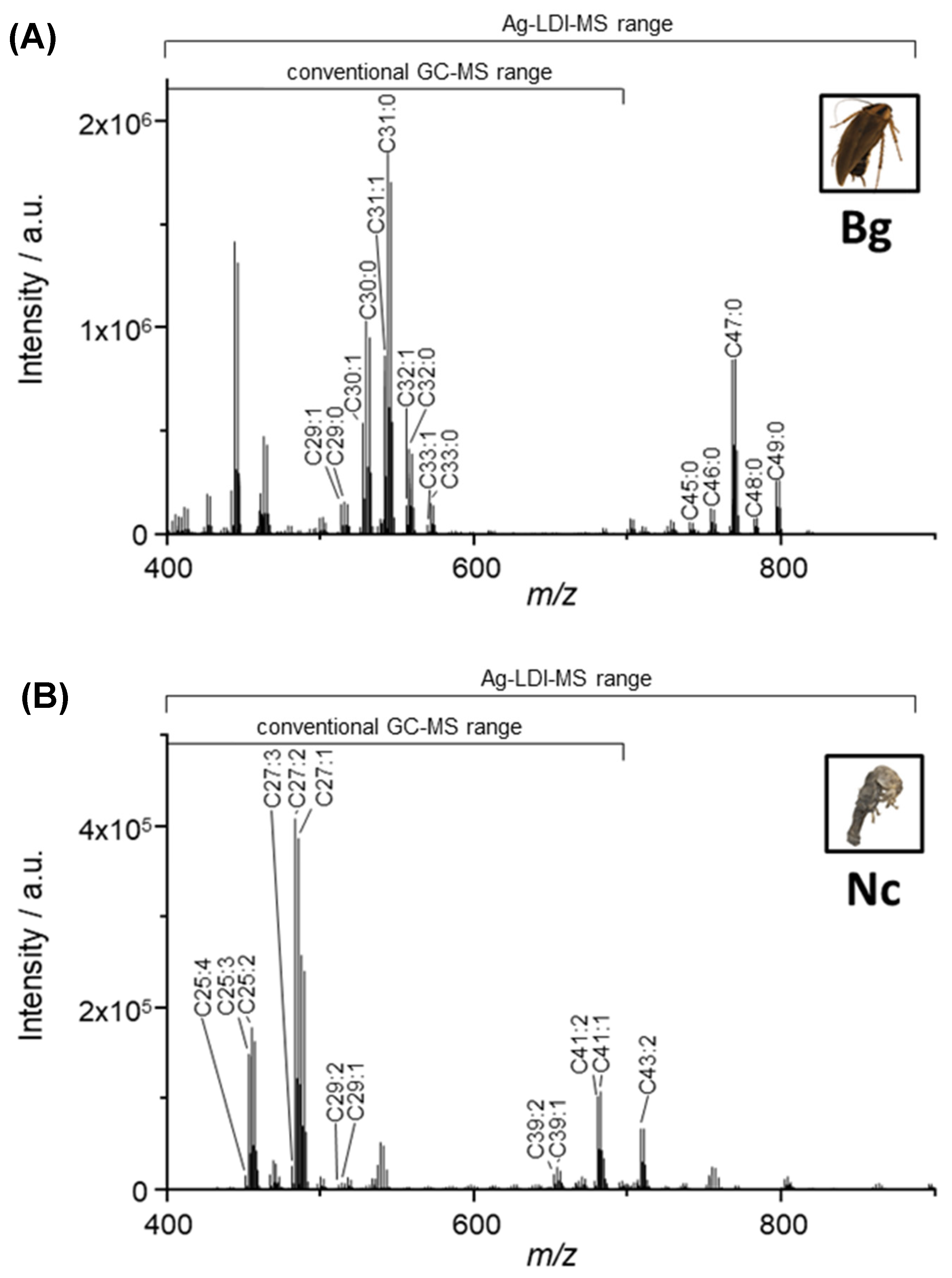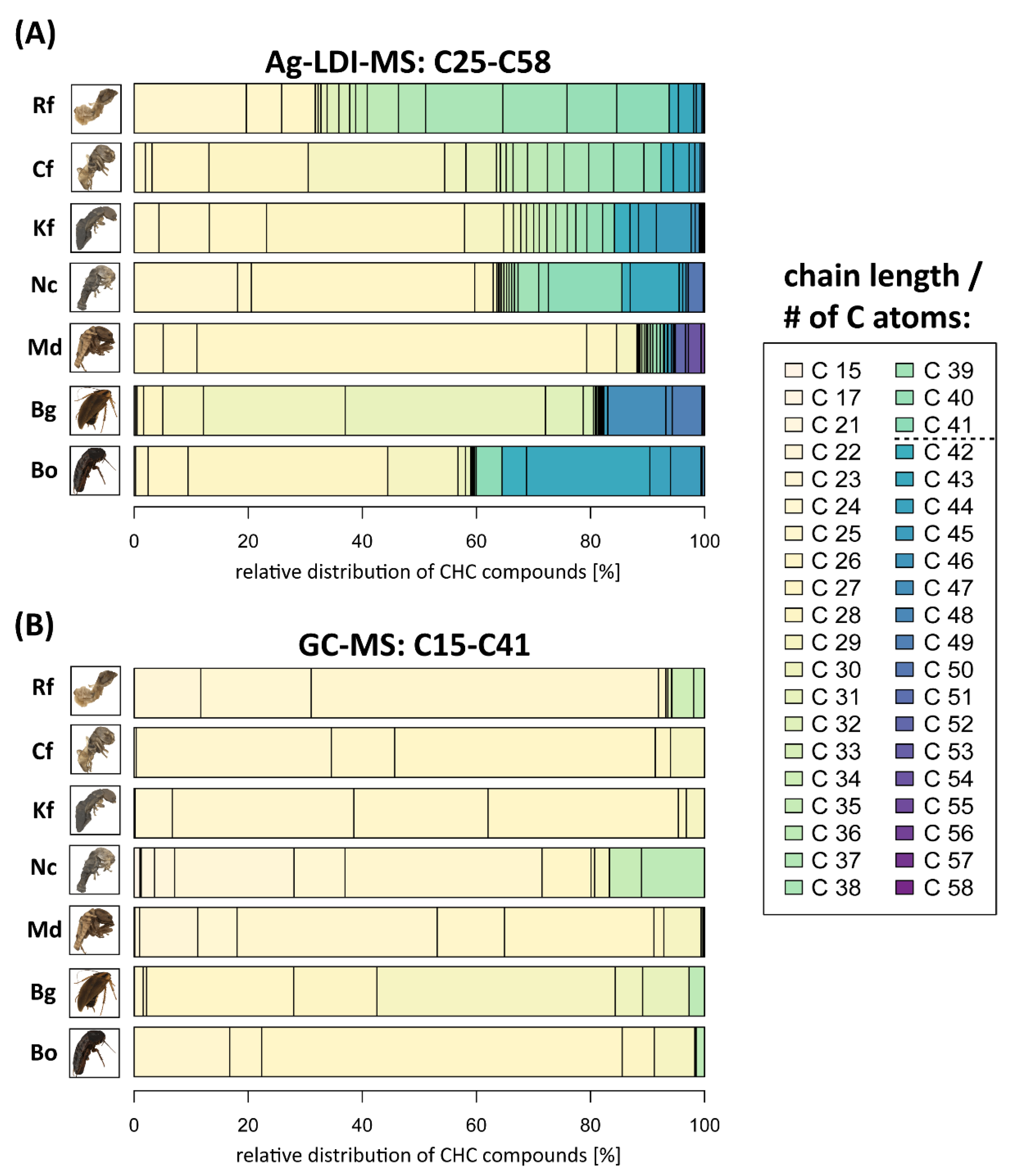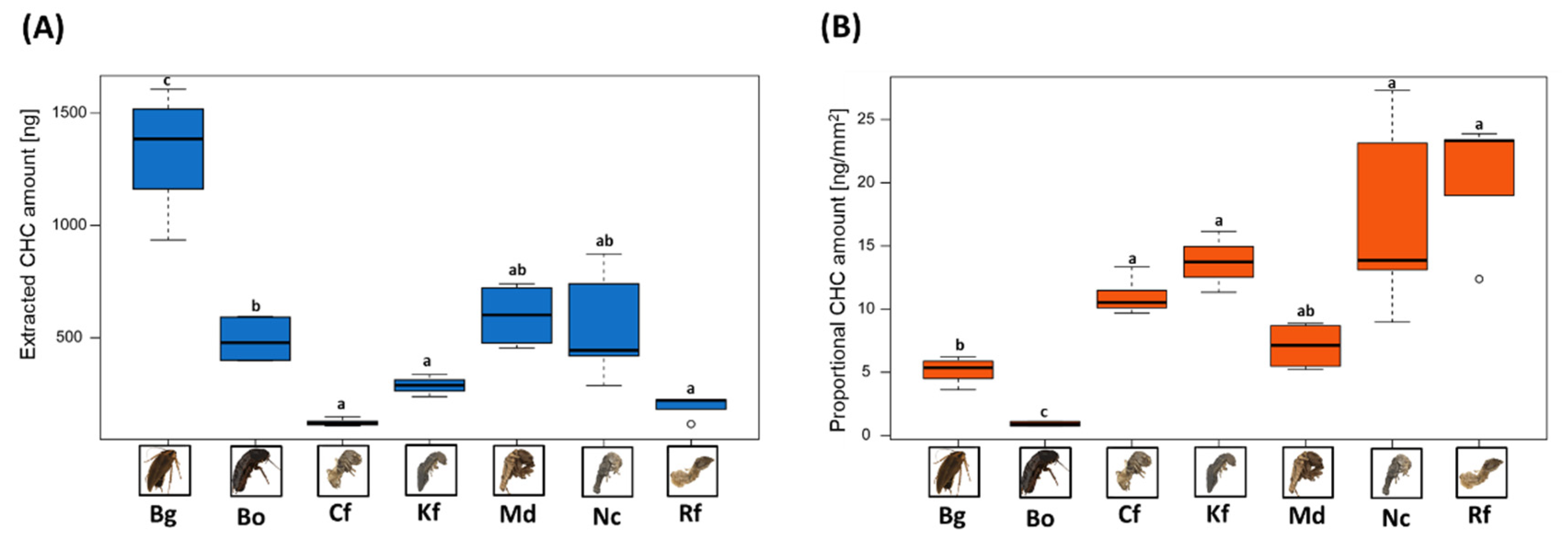Neglected Very Long-Chain Hydrocarbons and the Incorporation of Body Surface Area Metrics Reveal Novel Perspectives for Cuticular Profile Analysis in Insects
Abstract
:Simple Summary
Abstract
1. Introduction
2. Materials and Methods
2.1. Tested Termite and Cockroach Species
2.2. GC-MS Analysis of Surface Extracts
2.3. Ag-LDI-MS Analysis of Surface Extracts
2.4. Surface Area Measurements
3. Results
3.1. CHC Chain Length Distributions Incorporating Very-Long-Chain CHCs
3.2. Assessment of CHC Amounts in Relation to Body Surface Areas
4. Discussion
5. Conclusions
Supplementary Materials
Author Contributions
Funding
Institutional Review Board Statement
Informed Consent Statement
Data Availability Statement
Acknowledgments
Conflicts of Interest
References
- Wigglesworth, V.B. The physiology of the cuticle and of ecdysis in Rhodnius prolixus (Triatomidae, Hemiptera); with special reference to the function of the oenocytes and of the dermal glands. Q. J. Microsc. Sci. 1933, 76, 269–318. [Google Scholar] [CrossRef]
- Blount, B.K.; Chibnall, A.C.; El Mangouri, H.A. The wax of the white pine chermes. Biochem. J. 1937, 31, 1375–1378. [Google Scholar] [CrossRef]
- Chibnall, A.C.; Piper, S.H.; Pollard, A.; Williams, E.F.; Sahai, P.N. The constitution of the priary alcohols, fatty acids and paraffins present in plant and insect waxes. Biochem. J. 1934, 28, 2189–2208. [Google Scholar] [CrossRef]
- Baker, G.L.; Padmore, J.; Vroman, H.E. Hydrocarbons of American cockroach. Biochem. Biophys. Res. Commun. 1963, 13, 360–365. [Google Scholar] [CrossRef]
- Nelson, D.R.; Sukkestad, D.R. Normal and branched aliphatic hydrocarbons from the eggs of the tobacco hornworm. Biochemistry 1970, 9, 4601–4611. [Google Scholar] [CrossRef] [PubMed]
- Martin, M.M.; MacConnell, J.G. The alkanes of the ant, Atta colombica. Tetrahedron 1970, 26, 307–319. [Google Scholar] [CrossRef] [Green Version]
- Nelson, D.R.; Blomquist, G.J. Insect waxes. In Waxes: Chemistry, Molecular Biology and Functions; Hamilton, R.J., Ed.; Oily Press: Dundee, Scotland, 1995; pp. 1–90. [Google Scholar]
- Blomquist, G.J.; Bagnères, A.G. Insect Hydrocarbons: Biology, Biochemistry, and Chemical Ecology; Cambridge University Press: Cambridge, UK, 2010. [Google Scholar]
- Cvacka, J.; Jiros, P.; Sobotnik, J.; Hanus, R.; Svatos, A. Analysis of insect cuticular hydrocarbons using matrix-assisted laser desorption/ionization mass spectrometry. J. Chem. Ecol. 2006, 32, 409–434. [Google Scholar] [CrossRef]
- Gibbs, A.G. Water-proofing properties of cuticular lipids. Am. Zool. 1998, 38, 471–482. [Google Scholar] [CrossRef]
- Gibbs, A.; Pomonis, J.G. Physical properties of insect cuticular hydrocarbons: The effects of chain-length, methyl-branching and unsaturation. Comp. Biochem. Physiol. A Mol. Integr. Physiol. 1995, 112, 243–249. [Google Scholar] [CrossRef]
- Bien, T.; Gadau, J.; Schnapp, A.; Yew, J.Y.; Sievert, C.; Dreisewerd, K. Detection of very long-chain hydrocarbons by laser mass spectrometry reveals novel species-, sex-, and age-dependent differences in the cuticular profiles of three Nasonia species. Anal. Bioanal. Chem. 2019, 411, 2981–2993. [Google Scholar] [CrossRef]
- Schnapp, A.; Niehoff, A.-C.; Koch, A.; Dreisewerd, K. Laser desorption/ionization mass spectrometry of lipids using etched silver substrates. Methods 2016, 104, 194–203. [Google Scholar] [CrossRef]
- Lihoreau, M.; Rivault, C. Kin recognition via cuticular hydrocarbons shapes cockroach social life. Behav. Ecol. 2008, 20, 46–53. [Google Scholar] [CrossRef]
- Weil, T.; Hoffmann, K.; Kroiss, J.; Strohm, E.; Korb, J. Scent of a queen—cuticular hydrocarbons specific for female reproductives in lower termites. Sci. Nat. 2009, 96, 315–319. [Google Scholar] [CrossRef]
- Bagnères, A.-G.; Hanus, R. Communication and social regulation in termites. In Social Recognition in Invertebrates: The Knowns and the Unknowns; Aquiloni, L., Tricarico, E., Eds.; Springer International Publishing: Cham, Switzerland, 2015; pp. 193–248. [Google Scholar]
- Inward, D.; Beccaloni, G.; Eggleton, P. Death of an order: A comprehensive molecular phylogenetic study confirms that termites are eusocial cockroaches. Biol. Lett. 2007, 3, 331–335. [Google Scholar] [CrossRef]
- Thoms, E.M.; Robinson, W.H. Distribution and movement of the oriental cockroach (Orthoptera: Blattidae) around apartment buildings. Environ. Entomol. 1987, 16, 731–737. [Google Scholar] [CrossRef]
- Thoms, E.M.; Robinson, W.H. Distribution, seasonal abundance, and pest status of the oriental cockroach (Orthoptera: Blattidae) and an Evaniid wasp (Hymenoptera: Evaniidae) in urban apartments. J. Econ. Entomol. 1986, 79, 431–436. [Google Scholar] [CrossRef]
- Edwards, J.P.; Short, J.E. Elimination of a population of the oriental cockroach (Dictyoptera: Blattidae) in a simulated domestic environment with the insect juvenile hormone analogue (S)-hydroprene. J. Econ. Entomol. 1993, 86, 436–443. [Google Scholar] [CrossRef]
- Rivault, C.; Cloarec, A.; Sreng, L. Cuticular extracts inducing aggregation in the German cockroach, Blattella germanica (L.). J. Insect Physiol. 1998, 44, 909–918. [Google Scholar] [CrossRef]
- Pei, X.J.; Chen, N.; Bai, Y.; Qiao, J.W.; Li, S.; Fan, Y.L.; Liu, T.X. BgFas1: A fatty acid synthase gene required for both hydrocarbon and cuticular fatty acid biosynthesis in the German cockroach, Blattella germanica (L.). Insect Biochem. Mol. Biol. 2019, 112, 103203. [Google Scholar] [CrossRef]
- Gu, X.; Quilici, D.; Juarez, P.; Blomquist, G.J.; Schal, C. Biosynthesis of hydrocarbons and contact sex-pheromone and their transport by lipophorin in females of the german cockroach (Blattella germanica). J. Insect Physiol. 1995, 41, 257–267. [Google Scholar] [CrossRef]
- Fan, Y.L.; Zurek, L.; Dykstra, M.J.; Schal, C. Hydrocarbon synthesis by enzymatically dissociated oenocytes of the abdominal integument of the german cockroach, Blattella germanica. Sci. Nat. 2003, 90, 121–126. [Google Scholar] [CrossRef]
- Abe, T. Evolution of life types in termites. In Evolution and Coadaptation in Biotic Communities; Kawano, S., Connell, J.H., Hidaka, T., Eds.; University of Tokyo Press: Tokyo, Japan, 1987; pp. 125–148. [Google Scholar]
- Korb, J.; Thorne, B. Sociality in termites. In Comparative Social Evolution; Rubenstein, D.R., Abbot, P., Eds.; Cambridge University Press: Cambridge, UK, 2017; pp. 124–153. [Google Scholar]
- Thorne, B.L. Evolution of eusociality in termites. Annu. Rev. Ecol. Syst. 1997, 28, 27–54. [Google Scholar] [CrossRef] [Green Version]
- Legendre, F.; Whiting, M.F.; Bordereau, C.; Cancello, E.M.; Evans, T.A.; Grandcolas, P. The phylogeny of termites (Dictyoptera: Isoptera) based on mitochondrial and nuclear markers: Implications for the evolution of the worker and pseudergate castes, and foraging behaviors. Mol. Phylogenet Evol. 2008, 48, 615–627. [Google Scholar] [CrossRef]
- Balbuena, M.S.; Gonzalez, A.; Farina, W.M. Characterization of cuticular hydrocarbons according to colony duties in the stingless bee Tetragonisca angustula. Apidologie 2018, 49, 185–195. [Google Scholar] [CrossRef]
- Ferveur, J.F.; Cortot, J.; Rihani, K.; Cobb, M.; Everaerts, C. Desiccation resistance: Effect of cuticular hydrocarbons and water content in Drosophila melanogaster adults. Peerj 2018, 6. [Google Scholar] [CrossRef] [PubMed] [Green Version]
- Blomquist, G.J.; Ginzel, M.D. Chemical ecology, biochemistry, and molecular biology of insect hydrocarbons. Annu. Rev. Entomol. 2021, 66, 45–60. [Google Scholar] [CrossRef] [PubMed]
- Kühsel, S.; Brückner, A.; Schmelzle, S.; Heethoff, M.; Blüthgen, N. Surface area–volume ratios in insects. Insect Sci. 2017, 24, 829–841. [Google Scholar] [CrossRef]
- Hadley, N.F. Surface waxes and integumentary permeability: Lipids deposited on or associated with the surface of terrestrial plants and animals help protect them from a lethal rate of desiccation. Am. Sci. 1980, 68, 546–553. [Google Scholar]
- Gibbs, A.G. Lipid melting and cuticular permeability: New insights into an old problem. J. Insect Physiol. 2002, 48, 391–400. [Google Scholar] [CrossRef]
- Pei, X.-J.; Fan, Y.-L.; Bai, Y.; Bai, T.-T.; Schal, C.; Zhang, Z.-F.; Chen, N.; Li, S.; Liu, T.-X. Modulation of fatty acid elongation in cockroaches sustains sexually dimorphic hydrocarbons and female attractiveness. PLoS Biol. 2021, 19. [Google Scholar] [CrossRef]
- Buddrick, O.; Jones, O.A.H.; Morrison, P.D.; Small, D.M. Heptane as a less toxic option than hexane for the separation of vitamin E from food products using normal phase HPLC. RSC Adv 2013, 3, 24063–24068. [Google Scholar] [CrossRef]
- Conkerton, E.; Wan, P.; Richard, O. Hexane and heptane as extraction solvents for cottonseed: A laboratory-scale study. J. Am. Oil Chem. Soc. 1995, 72, 963–965. [Google Scholar] [CrossRef]
- Ströbel, B.; Schmelzle, S.; Blüthgen, N.; Heethoff, M. An automated device for the digitization and 3D modelling of insects, combining extended-depth-of-field and all-side multi-view imaging. ZooKeys 2018, 759. [Google Scholar] [CrossRef] [PubMed]
- Chung, H.; Carroll, S.B. Wax, sex and the origin of species: Dual roles of insect cuticular hydrocarbons in adaptation and mating. Bioessays 2015, 37, 822–830. [Google Scholar] [CrossRef]
- Kather, R.; Martin, S.J. Evolution of cuticular hydrocarbons in the Hymenoptera: A meta-analysis. J. Chem. Ecol. 2015, 41, 871–883. [Google Scholar] [CrossRef] [PubMed] [Green Version]
- Otte, T.; Hilker, M.; Geiselhardt, S. Phenotypic plasticity of cuticular hydrocarbon profiles in insects. J. Chem. Ecol. 2018, 44, 235–247. [Google Scholar] [CrossRef] [PubMed]
- Richard, F.J.; Hunt, J.H. Intracolony chemical communication in social insects. Insectes Soc. 2013, 60, 275–291. [Google Scholar] [CrossRef]
- Chung, H.; Loehlin, D.W.; Dufour, H.D.; Vaccarro, K.; Millar, J.G.; Carroll, S.B. A single gene affects both ecological divergence and mate choice in Drosophila. Science 2014, 343, 1148–1151. [Google Scholar] [CrossRef] [PubMed]
- Ingleby, F.C. Insect cuticular hydrocarbons as dynamic traits in sexual communication. Insects 2015, 6, 732–742. [Google Scholar] [CrossRef] [PubMed] [Green Version]
- Buellesbach, J.; Vetter, S.G.; Schmitt, T. Differences in the reliance on cuticular hydrocarbons as sexual signaling and species discrimination cues in parasitoid wasps. Front. Zool. 2018, 15. [Google Scholar] [CrossRef] [PubMed] [Green Version]
- Menzel, F.; Morsbach, S.; Martens, J.H.; Rader, P.; Hadjaje, S.; Poizat, M.; Abou, B. Communication versus waterproofing: The physics of insect cuticular hydrocarbons. J. Exp. Biol. 2019, 222. [Google Scholar] [CrossRef]
- Heggeseth, B.; Sim, D.; Partida, L.; Maroja, L.S. Influence of female cuticular hydrocarbon (CHC) profile on male courtship behavior in two hybridizing field crickets Gryllus firmus and Gryllus pennsylvanicus. BMC Evol. Biol. 2020, 20. [Google Scholar] [CrossRef]
- Smith, A.A.; Millar, J.G.; Suarez, A.V. Comparative analysis of fertility signals and sex-specific cuticular chemical profiles of Odontomachus trap-jaw ants. J. Exp. Biol. 2016, 219, 419–430. [Google Scholar] [CrossRef] [PubMed] [Green Version]
- Zhang, B.; Xue, H.-J.; Song, K.-Q.; Liu, J.; Li, W.-Z.; Nie, R.-E.; Yang, X.-K. Male mate recognition via cuticular hydrocarbons facilitates sexual isolation between sympatric leaf beetle sister species. J. Insect Physiol. 2014, 70, 15–21. [Google Scholar] [CrossRef]
- Jallon, J.M. A few chemical words exchanged by Drosophila during courtship and mating. Behav. Genet. 1984, 14, 441–478. [Google Scholar] [CrossRef] [PubMed]
- Van Oystaeyen, A.; Oliveira, R.C.; Holman, L.; van Zweden, J.S.; Romero, C.; Oi, C.A.; d’Ettorre, P.; Khalesi, M.; Billen, J.; Wäckers, F.; et al. Conserved class of queen pheromones stops social insect workers from reproducing. Science 2014, 343, 287–290. [Google Scholar] [CrossRef] [PubMed]
- Marcillac, F.; Ferveur, J.F. A set of female pheromones affects reproduction before, during and after mating in Drosophila. J. Exp. Biol. 2004, 207, 3927–3933. [Google Scholar] [CrossRef] [PubMed] [Green Version]
- Ferveur, J.-F. Cuticular hydrocarbons: Their evolution and roles in Drosophila pheromonal communication. Behav. Genet. 2005, 35, 279–295. [Google Scholar] [CrossRef] [PubMed]
- Everaerts, C.; Lacaille, F.; Ferveur, J.F. Is mate choice in Drosophila males guided by olfactory or gustatory pheromones? Anim. Behav. 2010, 79, 1135–1146. [Google Scholar] [CrossRef] [Green Version]
- Sharma, K.R.; Enzmann, B.L.; Schmidt, Y.; Moore, D.; Jones, G.R.; Parker, J.; Berger, S.L.; Reinberg, D.; Zwiebel, L.J.; Breit, B.; et al. Cuticular hydrocarbon pheromones for social behavior and their coding in the ant antenna. Cell Rep. 2015, 12, 1261–1271. [Google Scholar] [CrossRef]
- Luo, Y.G.; Zhang, Y.W.; Farine, J.P.; Ferveur, J.F.; Ramirez, S.; Kopp, A. Evolution of sexually dimorphic pheromone profiles coincides with increased number of male-specific chemosensory organs in Drosophila prolongata. Ecol. Evol. 2019, 9, 13608–13618. [Google Scholar] [CrossRef] [Green Version]
- Cerkowniak, M.; Puckowski, A.; Stepnowski, P.; Gołębiowski, M. The use of chromatographic techniques for the separation and the identification of insect lipids. J. Chromatogr. B 2013, 937, 67–78. [Google Scholar] [CrossRef] [PubMed]
- Sutton, P.A.; Wilde, M.J.; Martin, S.J.; Cvacka, J.; Vrkoslav, V.; Rowland, S.J. Studies of long chain lipids in insects by high temperature gas chromatography and high temperature gas chromatography-mass spectrometry. J. Chromatogr. A 2013, 1297, 236–240. [Google Scholar] [CrossRef] [PubMed]
- Akino, T. Cuticular hydrocarbons of Formica truncorum (Hymenoptera: Formicidae): Description of new very long chained hydrocarbon components. Appl. Entomol. Zool. 2006, 41, 667–677. [Google Scholar] [CrossRef] [Green Version]
- Ehlers, A.W.; de Koster, C.G.; Meier, R.J.; Lammertsma, K. MALDI-TOF-MS of saturated polyolefins by coordination of metal cations: A theoretical study. J. Phys. Chem. A 2001, 105, 8691–8695. [Google Scholar] [CrossRef]
- Premkumar, J.R.; Sastry, G.N. Cation–alkane interaction. J. Phys. Chem. A 2014, 118, 11388–11398. [Google Scholar] [CrossRef] [PubMed]
- Sprenger, P.P.; Menzel, F. Cuticular hydrocarbons in ants (Hymenoptera: Formicidae) and other insects: How and why they differ among individuals, colonies, and species. Myrmecol. News 2020, 30, 1–26. [Google Scholar] [CrossRef]
- Engl, T.; Eberl, N.; Gorse, C.; Krüger, T.; Schmidt, T.H.P.; Plarre, R.; Adler, C.; Kaltenpoth, M. Ancient symbiosis confers desiccation resistance to stored grain pest beetles. Mol. Ecol. 2018, 27, 2095–2108. [Google Scholar] [CrossRef]
- Kalra, B.; Parkash, R.; Aggarwal, D.D. Divergent mechanisms for water conservation in Drosophila species. Entomol. Exp. Appl. 2014, 151, 43–56. [Google Scholar] [CrossRef]
- Lockey, K.H. The thickness of some insect epicuticular wax layers. J. Exp. Biol. 1960, 37, 316–329. [Google Scholar] [CrossRef]



| Species | Surface [mm2] |
|---|---|
| Rf | 9.58 |
| Cf | 11.07 |
| Kf | 20.97 |
| Md | 86.94 |
| Nc | 31.99 |
| Bo | 536.97 |
| Bg | 258.13 |
Publisher’s Note: MDPI stays neutral with regard to jurisdictional claims in published maps and institutional affiliations. |
© 2022 by the authors. Licensee MDPI, Basel, Switzerland. This article is an open access article distributed under the terms and conditions of the Creative Commons Attribution (CC BY) license (https://creativecommons.org/licenses/by/4.0/).
Share and Cite
Golian, M.; Bien, T.; Schmelzle, S.; Esparza-Mora, M.A.; McMahon, D.P.; Dreisewerd, K.; Buellesbach, J. Neglected Very Long-Chain Hydrocarbons and the Incorporation of Body Surface Area Metrics Reveal Novel Perspectives for Cuticular Profile Analysis in Insects. Insects 2022, 13, 83. https://doi.org/10.3390/insects13010083
Golian M, Bien T, Schmelzle S, Esparza-Mora MA, McMahon DP, Dreisewerd K, Buellesbach J. Neglected Very Long-Chain Hydrocarbons and the Incorporation of Body Surface Area Metrics Reveal Novel Perspectives for Cuticular Profile Analysis in Insects. Insects. 2022; 13(1):83. https://doi.org/10.3390/insects13010083
Chicago/Turabian StyleGolian, Marek, Tanja Bien, Sebastian Schmelzle, Margy Alejandra Esparza-Mora, Dino Peter McMahon, Klaus Dreisewerd, and Jan Buellesbach. 2022. "Neglected Very Long-Chain Hydrocarbons and the Incorporation of Body Surface Area Metrics Reveal Novel Perspectives for Cuticular Profile Analysis in Insects" Insects 13, no. 1: 83. https://doi.org/10.3390/insects13010083
APA StyleGolian, M., Bien, T., Schmelzle, S., Esparza-Mora, M. A., McMahon, D. P., Dreisewerd, K., & Buellesbach, J. (2022). Neglected Very Long-Chain Hydrocarbons and the Incorporation of Body Surface Area Metrics Reveal Novel Perspectives for Cuticular Profile Analysis in Insects. Insects, 13(1), 83. https://doi.org/10.3390/insects13010083







